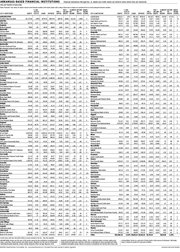The financial condition of the 109 banks based in Arkansas has improved significantly in the past two years, said Candace Franks, commissioner of the Arkansas State Bank Department.
Since 2012, bank assets have increased 7 percent to $65.5 billion, and profits are up more than 16 percent to $810 million.
"The institutions have worked through their problems," Franks said. "Of course, that goes along with the recovery" from the recession of December 2007 to June 2009.
"We're also seeing a good improvement in loan demand, which is a good thing for the state," Franks said.
Julie Stackhouse, senior vice president with the Federal Reserve Bank of St. Louis, agreed.
The improvement in loan demand is hard to recognize because the four largest banks in the state -- Arvest Bank of Fayetteville, Centennial Bank of Conway, Bank of the Ozarks in Little Rock and Simmons First National Bank in Pine Bluff -- do significant business out of state, Stackhouse said.
"So we're never sure if their loan growth is in Arkansas or Florida or Missouri," Stackhouse said.
But excluding those four banks, there is "a nice level of loan growth starting to occur in Arkansas," Stackhouse said.
"Granted, it's mostly in the commercial real estate area, but that's not bad," she said. "We had pulled back pretty hard in that area [after the recession]. But at least we are seeing signs of generalized loan growth."
Excluding the four largest banks, loans in Arkansas grew by about 4 percent last year, Stackhouse said.
If you include the four largest banks, loans by Arkansas banks were up about 8 percent last year, said Gary Corner, senior bank examiner with the Federal Reserve in St. Louis.
The 109 Arkansas-based banks, as of Dec. 31, represent a reduction of 165 banks from 274 based in the state 20 years ago and a drop of 59 banks from 168 based in the state in December 2004.
The number is certain to continue to decline. At least three more banks in the state will disappear in the first quarter this year.
Early this year, Bear State Financial consolidated its three banks -- First Federal Bank of Harrison, First National Bank of Hot Springs and Heritage Bank of Jonesboro -- into one bank, Bear State Bank of Little Rock.
Nationally, bank acquisitions finally are rebounding to levels seen before the recession.
In recent years, there have been 275 to 300 bank acquisitions a year nationally, Corner said. There were 290 acquisitions last year, Corner said. That is 4 percent to 4.5 percent of the banks in the country that sold last year.
If the same percentage of Arkansas-based banks were to sell, that would equal about three or four a year, Corner said.
"So if you see four transactions a year in Arkansas, that would be about normal," Stackhouse said. "But if you start to see 10, then you'd probably start scratching your head."
Only six banks in Arkansas are still under enforcement actions from federal regulators and six others are facing less severe sanctions from the Arkansas State Bank Department, a significant decline from four years ago.
That is a 71 percent decline from the peak in 2011 of 41 Arkansas-based banks facing reprimands -- 17 by federal regulators and 24 by state regulators.
The six banks still facing federal sanctions, as of Dec. 31, were Allied Bank of Mulberry, Forrest City Bank, One Bank & Trust of Little Rock, HomeBank of Arkansas in Portland, Ozark Heritage Bank of Mountain View and Pinnacle Bank of Rogers, said Karen Dorway, president and director of research at Bauer Financial in Coral Gables, Fla.
Federal regulators recently announced that they had terminated a 2009 order against First National Bank of Crossett.
Dorway didn't elaborate on the severity of the enforcement actions. Some could be relatively minor, such as violating the Bank Secrecy Act, Dorway said.
The Arkansas State Bank Department does not identify banks it has sanctioned.
Nationally, the number of banks facing enforcement actions from regulators has declined significantly in recent years, Dorway said.
"The overall financial condition of banks [nationally] has improved dramatically over the last number of years," Dorway said. "And the new [sanctions] being issued tend to be more common compliance issues rather than a shortage of capital or a lack of profitability or [an excess of] nonperforming assets."
SundayMonday Business on 03/29/2015


